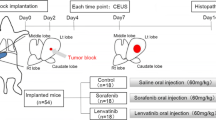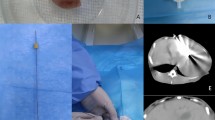Abstract
The aim of our study was to investigate the application of contrast-enhanced ultrasound (CEUS) and its quantification analysis for the prediction of early treatment response of sorafenib on rabbit VX2 liver tumor model. Rabbits were implanted VX2 tumor mass to establish a liver tumor model. Fourteen days after tumor implantation, rabbits presented with single liver tumor were randomly divided into two groups. Rabbits in treatment group were given by gavage once a day for 14 days with sorafenib suspension at a dose of 30 mg/kg, whereas rabbits in control group were given saline by gavage of the same volume. CEUS was performed before treatment and 3, 7, 14 days after treatment for the analysis of tumor size, enhancement pattern, and necrosis range. The time intensity curve (TIC) was used to obtain quantitative parameters of enhancement patterns. Before sorafenib administration, tumor volumes ranged from 0.24 to 0.75 cm3 (mean 0.49 ± 0.18 cm3) in treatment group and 0.24 to 0.44 cm3 (mean 0.30 ± 0.12 cm3) in control group. The dynamic enhancement patterns of tumors were homogeneous hyper-enhancement (n = 8), heterogeneous hyper-enhancement (n = 4), and peripheral rim-like enhancement (n = 2). All tumors of the treatment group presented with peripheral rim-like enhancement with large necrotic area after sorafenib administration, whereas tumors of the control group showed heterogeneous hyper-enhancement (n = 5) and peripheral rim-like enhancement (n = 2). There was a significant difference in area under the curve (AUC) before and after sorafenib treatment (P = 0.045). CEUS may be of value in the evaluation of early therapeutic response after sorafenib administration.





Similar content being viewed by others
References
International Consensus Group for Hepatocellular Neoplasia. Pathologic diagnosis of early hepatocellular carcinoma: a report of the international consensus group for hepatocellular neoplasia. Hepatology. 2009;49(2):658–64.
Huynh H. Molecularly targeted therapy in hepatocellular carcinoma. Biochem Pharmacol. 2010;80(5):550–60.
Llovet JM, Ricci S, Mazzaferro V, Hilgard P, Gane E, Blanc JF, et al. Sorafenib in advanced hepatocellular carcinoma. N Engl J Med. 2008;359(4):378–90.
Bruix J, Raoul JL, Sherman M, Mazzaferro V, Bolondi L, Craxi A, et al. Efficacy and safety of sorafenib in patients with advanced hepatocellular carcinoma: subanalyses of a phase III trial. J Hepatol. 2012;57(4):821–9.
Sun S, Schiller JH. Angiogenesis inhibitors in the treatment of lung cancer. Crit Rev Oncol Hematol. 2007;62(2):93–104.
Cyran CC, Schwarz B, Paprottka PM, Sourbron S, von Einem JC, Dietrich O, et al. In vivo monitoring of sorafenib therapy effects on experimental prostate carcinomas using dynamic contrast-enhanced MRI and macromolecular contrast media. Cancer Imaging. 2013;13(4):557–66.
Goggi JL, Bejot R, Moonshi SS, Bhakoo KK. Stratification of 18 F-labeled PET imaging agents for the assessment of antiangiogenic therapy responses in tumors. J Nucl Med. 2013;54(9):1630–6.
Anderson H, Price P, Blomley M, Leach MO, Workman P. Measuring changes in human tumour vasculature in response to therapy using functional imaging techniques. Br J Cancer. 2001;85(8):1085–93.
Rouffiac V, Bouquet C, Lassau N, Opolon P, Koscielny S, Peronneau P, et al. Validation of a new method for quantifying in vivo murine tumor necrosis by sonography. Investig Radiol. 2004;39(6):350–6.
Lamuraglia M, Bridal SL, Santin M, Izzi G, Rixe O, Paradiso A, et al. Clinical relevance of contrast-enhanced ultrasound in monitoring anti-angiogenic therapy of cancer: current status and perspectives. Crit Rev Oncol Hematol. 2010;73(3):202–12.
Luo W, Zhou X, Zheng X, He G, Yu M, Li Q, et al. Role of sonography for implantation and sequential evaluation of a VX2 rabbit liver tumor model. J Ultrasound Med. 2010;29(1):51–60.
Zhou P, Zhou P, He W, Wang LH, Li XH, Tian SM, et al. The influence of blood supply on high intensity focused ultrasound: a preliminary study on rabbit hepatic VX2 tumors of different ages. Acad Radiol. 2012;19(1):40–7.
Yoshida K, Hirokawa T, Moriyasu F, Liu L, Liu GJ, Yamada M, et al. Arterial-phase contrast-enhanced ultrasonography for evaluating anti-angiogenesis treatment: a pilot study. World J Gastroenterol. 2011;17(8):1045–50.
Zhang YJ, Chen MS, Li JQ, Zhang YQ, Zhong C, Liang HH. Radiofrequency ablation combined with ethanol injection for liver cancer treatment—an experimental study. Ai Zheng. 2006;25(9):1092–6.
Lin WY, Chen J, Lin Y, Han K. Implantation of VX2 carcinoma into the liver of rabbits: a comparison of three direct-injection methods. J Vet Med Sci. 2002;64(7):649–52.
He W, Wang W, Zhou P, Wang YX, Zhou P, Li RZ, et al. Enhanced ablation of high intensity focused ultrasound cardiovasc with microbbles: an experimental study on rabbit hepatic VX2 tumors. Cardiovasc Intervent Radiol. 2011;34(5):1050–7.
Sugimoto K, Moriyasu F, Saito K, Rognin N, Kamiyama N, Furuichi Y, et al. Hepatocellular carcinoma treated with sorafenib: early detection of treatment response and major adverse events by contrast-enhanced US. Liver Int. 2013;33(4):605–15.
Frampas E, Lassau N, Zappa M, Vullierme MP, Koscielny S, Vilgrain V. Advanced hepatocellular carcinoma: early evaluation of response to targeted therapy and prognostic value of perfusion CT and dynamic contrast enhanced-ultrasound. Preliminary results. Eur J Radiol. 2013;82(5):e205–11.
Shiozawa K, Watanabe M, Kikuchi Y, Kudo T, Maruyama K, Sumino Y. Evaluation of sorafenib for hepatocellular carcinoma by contrast-enhanced ultrasonography: a pilot study. World J Gastroenterol. 2012;18(40):5753–8.
Wang Z, Yang G, Nie P, Fu J, Wang X, Liu D. Dynamical observation on biological progression of VX2 liver tumors to identify the optimal time for intervention in animal models. PLoS One. 2013;8(8):e74327.
Acknowledgments
This research is supported by the national Nature Science Foundation of China (81371577)
Conflicts of interest
None
Author information
Authors and Affiliations
Corresponding author
Additional information
Hai-Xia Yuan contributed equally to this work and should be considered co-first author.
Rights and permissions
About this article
Cite this article
Kong, WT., Yuan, HX., Cai, H. et al. Early treatment response to sorafenib for rabbit VX2 orthotic liver tumors: evaluation by quantitative contrast-enhanced ultrasound. Tumor Biol. 36, 2593–2599 (2015). https://doi.org/10.1007/s13277-014-2877-x
Received:
Accepted:
Published:
Issue Date:
DOI: https://doi.org/10.1007/s13277-014-2877-x




